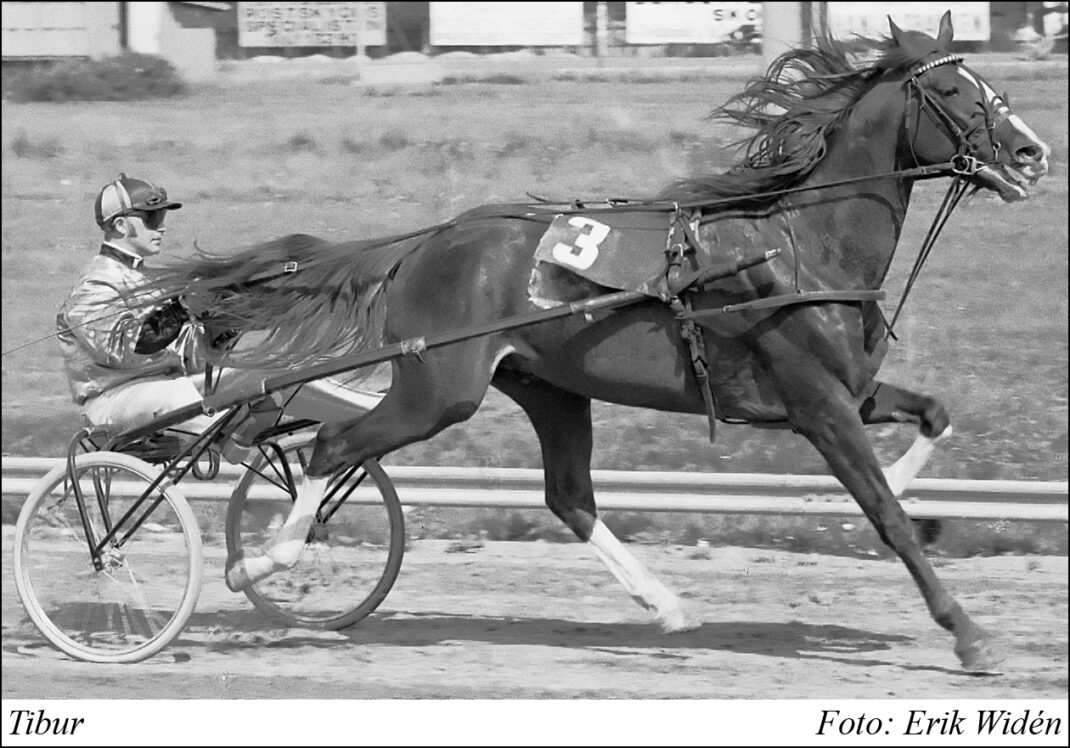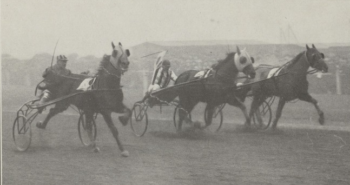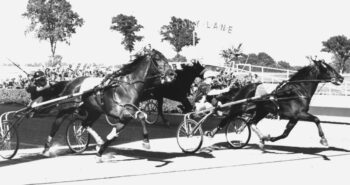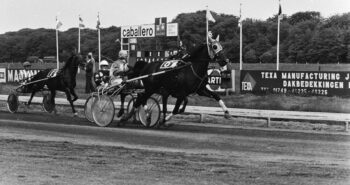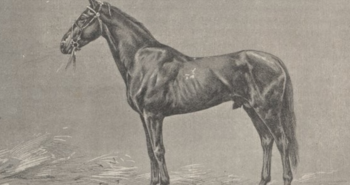French trotters that visited Sweden in the 50s tended to dominate and the desire to bring in French bloodlines were very strong. When the French-born Tibur was brought to Scandinavia, however, the colt was rejected by the Swedish breeding commission. However, following the old adage that “cream always rises to the top”, Tibur proved himself a true elite stallion but only got his chance because of a loophole in the rules.
The French-born colt was purchased by Folke Fredriksson and Magnus Lundahl for 30,000 French francs at a yearling auction in 1964. A son of Fandango and out of a Kairos mare, Tibur was a relatively small horse measuring 155 cm (15,1 hands) and a near clone of his famous sire. Except for his color, the beautiful chestnut had a distinctive white blaze and three white socks just like Fandango, and, also just like his famous sire, the front right foot had no sock.
“That devil“
In Sweden, Tibur spent time at several different trainers. He started at Gunnar Nordin, before moving to Bertil Karlsson in Kalmar. It was in Kalmar where he scored his first win, but not long after he was moved to trainer Algot Scott at Åby in Gothenburg. Scott recommended a patella operation, relatively common back then, which set the French chestnut back for a while. During his recovery, Tibur was moved to Stig Engberg’s stable at Solvalla. The horse was then advertised for sale, and a month later Engberg found a buyer. Tibur then was sold to Ture Gillberg (Stall Family) and assigned to Bertil Rogell who ran a stable together with Engberg at Solvalla.
Rogell recalled Tibur as a talented trotter who had a fair share of issues, both on and off the track. One caretaker had asked Rogell “that devil Tibur, can I please not have to deal with him?” Although Tibur was not generally aggressive or mean he had plenty of willpower, something very common in French trotters. Tibur’s biggest challenge, though, was that he had a lot of problems with his hooves. Rogell recalled that Gunnar Nordin would later complain that it was almost impossible to shoe the trotter. On the track, Tibur was described as a “heaven or hell” horse. Being linegaited he would occasionally kick himself. If he was on his best behavior, however, he was very difficult to beat. He never even started in mile-long races since he completely lacked gate speed but was exceptionally strong. In one race over 3100 meter (almost 2 miles long) at Kalmar he was roughly 100 meter (90 yards) behind after one lap (on a 5/8th track), but then he got going and won by roughly 70 meters (more than 60 yards). Tibur would simply wear down his opponents with brute strength.
Using shoe cream
In Scandinavia today, trotters will get a warning for poor gait, but back in the late 60s they were disqualified immediately if the judges were unhappy. Tibur would occasionally have trouble putting his feet right and continuously ran the risk of being disqualified – which happened a few times. That one front foot was white and the other brown made the problem visually quite obvious at times. But Rogell had a solution, he put white bandages on both front feet. Suddenly things looked much better visually! But Karlsson, the previous trainer, had an even better solution. He used brown shoe cream on Tibur’s white front foot. Interestingly enough, Tibur was never disqualified when using the shoe cream…
Rogell saw Tibur as a very talented horse, though, but found that his bad nerves and occasionally made him break stride for no apparent reason. His inability to leave quickly meant he had to work his butt off in every race. Tibur gained notoriety for being a “right winger” as he was usually found three- or four wide. When he won Frances Bulwarks Lopp in 1971, the colt trotted three wide the last mile. Tage Stridberg, another trainer at Solvalla, stated that “It’s the worst I have ever seen” (in Scandinavia, when used in this context “worst” refers to something extraordinarily impressive).
The French chestnut is today often referred to as an average, or even below, trotter. It is hard to assess how good he was, also because he was so one-dimentional, but over longer distances Tibur was one of the better trotters in Scandinavia. He twice won the prestigious Harper Hanovers Lopp, the 2-mile race now hosted during the Elitlopp-weekend – back in 1970 and 1971 it was raced in July – and he beat some very good horses doing so. Tibur spent the 1969/70 winter meeting in France and took two wins at Vincennes.
The rejection
At 10, Tibur was purchased by Claes Braunerhjelm, owner of Sandemar Castle, for 40,000 SEK. The move was recommended by young trainer Stig H Johansson who trained all of Braunerhjelm’s horses. Though they were hoping to race Tibur, that proved impossible as the colt was past his best,. However, the primary motive for the purchase was to use him as a stallion on their own broodmares and to replace Sandemar’s aging stallion, Cahoot. Soon, however, they also acquired Urgent Yankee, and Tibur found himself at the bottom of the pecking order among the stallions – at least until his get hit the track.
In the 70s, any many years after, a colt could not stand as a public stud in Sweden unless he was approved by a breeding committee. The intention was to exclude stallions with unacceptable genetic defects, such as roaring, cryptorchidism etc., and those without an acceptable level of performances or pedigree. However well-intended, this was a problematic system that created a lot of questionable decisions because of the committee members’ subjective decisions. Tibur didn’t need committee approval to be bred to Sandemar’s own broodmares because of the “own mares” exception to the system; a stallion could be used on any broodmare belonging to the same registered owner. Ture Gillberg had already used this when he bred Tibur to two of his mares in both 1969 and 1970, resulting in three foals. The colt’s first-born, Amie Tiburina, was a very good mare in 70s. Tibur was not used as a stallion until 1974 when Sandemar, having bought him the previous year, used him on quite a few of their mares, something they did for the next four years. Braunerhjelm had a reputation for liking to gamble, and both Stig-H Johansson and Rolf Andersson, right-hand man at Sandemar, warned him about using an unused stallion on most of his mares – but Braunerhjelm wasn’t bothered by this.
In the fall of 1979, Tibur was shown to the committee but was rejected. There were a lot of negative veterinary remarks – though nothing that would outright disqualify him – his pedigree was described as “good” and his career results were described as “acceptable”. The committee noted he had a few good foals, but still concluded in the negative. Thus, the refusal was appealed. Tibur’s 75-crop, containing four horses, was nothing special but the 76-generation, though only containing three horses, were nothing short of spectacular. His son Mustard was arguably the best horse in his crop and set a new European record for 3-year-olds with 1.15,5 (2:01.2f), a record set in a biting cold -10 degrees C (14 F). Tibur’s daughter Minx was likewise one of the best fillies in the same crop. As a result, when 1979 was coming to an end and the appeal was considered, even the committee members must have started to feel embarassed with the initial rejection. After several months the appeal was upheld and Tibur was given permission to stand stud publicly at Sandemar.
A surprising stallion champion
It was, however, just a stroke of luck that Sandemar still owned the stallion. Sandemar’s finances were precarious at the time and on January 5, 1978 several broodmares, yearlings and Tibur himself were auctioned off. The highest bid for Tibur, a lowly 10,000 SEK, came from somebody who couldn’t afford to pay. Both Magnus Lundahl, his initial Swedish owner, and Bertil Rogell were given the opportunity to buy the horse for the same amount but both hesitantly declined. Tibur thus remained at Sandemar but was only used on one mare that year – a mating that produced Pixie, an extremely talented filly whose career was unfortunately cut short. But with Tibur’s exploit at stud, which was just around the corner, Sandemar’s financial situation would change for the better. Much better.
Swedish breeders didn’t share the hesitation of the committee members. In 1980, Tibur serviced 122 mares at booking and foal fees of 2000 + 5000 SEK. The same year, Mustard continued his exploits and starting winning against at aged elite trotters, such as in the CL Mullers Memorial, where he won ahead of Madison Avenue and Tarok, something very few 4-year-olds manage in Europe. In 1981 Ekivoque was second in the Swedish Derby and the following year the above-mentioned Pixie, a fantastic filly who won 10 out of 15 career starts, made her debut. Then, in 1984, Tibur’s exceptional 81-crop hit the track. It contained three genuine stars in Callit, winner of the 1987 International Trot, Emile and Big Spender, plus a few more good ones. The 83 crop saw several other exceptional trotters like Piper Cub and the brilliant but erratic Ata Star L – and Pale Amber and Thackeray weren’t shabby either. Tibur continued to deliver top trotters in every crop until his last one.
The starting percentage of his get, around 60 percent, was below those of other top stallions: the French stallion was generally bred to mares with an American pedigree to create foals with complete outcross pedigrees. Though this quite often resulted in very good, or better, trotters, there was a “heaven or hell” aspect to it: some of Tibur’s get just couldn’t trot at all and many owners and trainers wasted a lot of time trying to work wonders. The Tibur-yearlings that showed no talent literally had no talent. But other than that, Tibur was one of the first stallion that showed, on a large scale, the immense benefits in Franco-American crosses and, presumably because of the outcross effect, Tibur also worked wonders with some broodmares that otherwise produced absolutely nothing. His best foals had both speed and early talent from their maternal side plus strength and determination from their paternal side. Occasionally, though, the iron will that made Tibur could occasionally be a problem; some of his foals were not kids’ horses.
To illustrate how his status had changed, by 1987 the fees had increased from 2000 + 5000 SEK in 1980 to 5000 + 40000. Tibur was Swedish champion stallion in 1986 and 1987. None of his sons did particularly well at stud, Pale Amber was a bit of an exception, and his sireline is no longer alive. Tibur is the damsire of numerous good horses, particularly Queen L, and he is the damdamsire of Prix d’Amerique winner Maharajah.
Tibur died in 1990.
tibur
Bay colt born in Tournan En Brie, France in 1963. Died at Sandemar, Sweden in 1990.
Fandango – Hellenienne (Kairos)
121 starts: 25-6-10 – 1.19,5 (2:08f) – 186,440 SEK
Breeder: Edmond De Rothschild
Owners: Edmond De Rothschild – Folke Fredriksson and Magnus Lundahl – Ture Gillberg – Claes Braunerhjelm
Trainers: Gunnar Nordin, Bertil Karlsson, Algot Scott, Stig Engberg, Bertil Rogell and Stig H Johansson
Drivers: Gunnar Nordin, Bertil Karlsson, Algot Scott, Stig Engberg and Bertil Rogell
Groom: –

